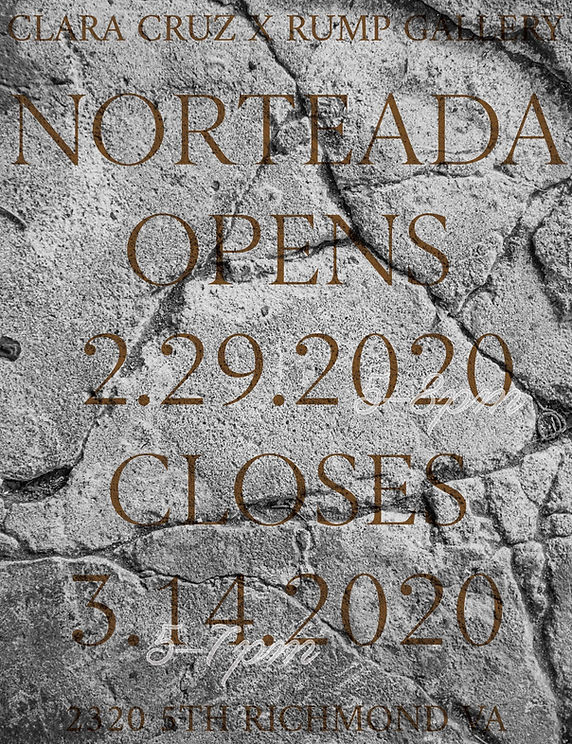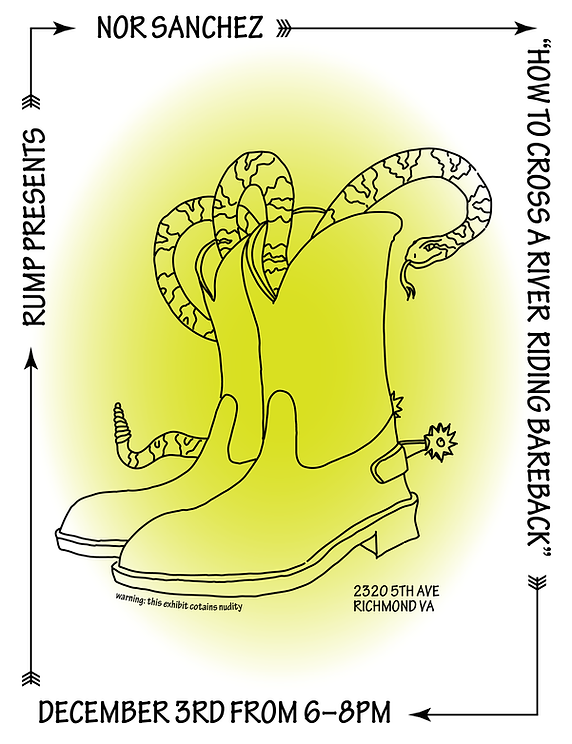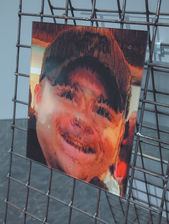top of page
Open: November 19 - December 17, 2022
𝘚𝘰𝘭𝘪𝘥, a collection of ink-on-paper nudes, reaches a point of transformation in accrual; in the bristle of sudden gooseflesh, in a moaning waft of morning breath, in the squishy, seductive banality of everyday intimacy.
In a contemporary inversion of the mythologized erotic nude of the 17th century, these bodies show up as themselves and triangulate around artistic familiarity—lovers, friends, willing acquaintances. Trans, cis, nonbinary, disabled, non-white, and non-normative bodies are featured, abstracted and cropped in keeping with each participant’s comfort level. 𝘚𝘰𝘭𝘪𝘥 centers feeling over identity, using visual specificity as a gateway to the universal gasp of recognition. The results are tender, strange, and deeply human.
Torey Akers is an artist and writer living in Brooklyn, NY. She holds MFAs from Cranbrook Academy of Art in Painting and from Hunter College in Creative Nonfiction. Her work has been featured at Spring Break Art Fair, the Danforth Museum of Art, and in New American Paintings, among other venues.
Torey Akers:Solid

Open: July 15 - August 16, 2020
Virtual Exhibition
In The Monsters Are Due, Harrison Moenich investigates images and their capacity to represent truth. Using atypical photographic production methods, portraits are created of high-profile court cases where injustice is prevalent. Moenich is interested in calling attention to these cases that benefit those with power, using willful blindness to avoid liability in wrongful acts. How has photography evolved since its inception as a tool for identifying criminals?
Moenich’s recent works have two components; a mounted photograph and various welded armatures. The armatures in this work serve as a metaphor for the prison industrial complex that these perpetrators serve to fill, yet somehow avoid occupying even after committing murder on camera. The photographs themselves are distorted portraits of mugshots and snapshots, circulated through social media and Google. As the images are disseminated they become warped further, an ever-eroding trace of a culprit who was freed by a broken system that they control.
Harrison Moenich: The Monsters Are Due

Opening Reception: Saturday, February 29, 5-8pm
Closing Reception: Saturday,March 14, 5-7pm
Norteada: Disoriented in geographic place, lost as in your mind. People here are cold and if it doesn’t snow that’s cause the salt wind off the water seeping damp into our bones. She said: there’s a certain shade of desert sky that happens mostly in recuerdos and corridos, never this far north.
Clara Cruz is an artist working across painting, installation and performance. She deals with issues of cultural hybridity, gendered labor and complex kinship ties, particularly in response to generations of mestizaje and migration in her community. She lives and works in New York and received a BFA in painting from Hunter College.
Clara Cruz: Norteada

Opening Reception: Saturday, January 18, 5-8pm
Closing Reception: Saturday, February 8, 5-7pm
I Wore Her All Around Me is an installation of text, imagery, and textiles by Trish J Gibson. This work exists around themes of southern tradition, queer connectivity, loss, growth, and generational inheritance. The texts are in the golden shovel format - using Dorothy Allison’s poems from her work, The Women Who Hate Me as a structure for the writings. The textiles are placed within the space as tokens which quantify the existence of a connection between a physical and spirited matriarchy which both exists in Gibson’s history and is summoned within the space itself. I Wore Her All Around Me is a deeply personal account of the process of growing up as a queer woman within a rural southern structure, coming out, and reclaiming one's own narrative.
Trish J Gibson is a Southern-American photographer and writer originally from East Tennessee, currently living and working in Richmond, Virginia. Gibson’s work revolves around interpersonal relationships, southern traditions, rural queerness, oral retellings, and the complicated nature of excavated histories.
Trish J. Gibson: I Wore Her All Around Me

Reception: Saturday, February 22, 5-8pm
As collaborative artists, we focus on relationships - with each other, with our body, and with physical spaces. Our work is performative, and the objects that we create act as documentation of our shared experiences. The ongoing felt works are playful and bright, inspiring viewers to join in on the warm soapy making. Wet felting is a process that is not exact or time consuming, and often we ask for volunteers to join us and learn the basic skills in exchange for their time. Finished pieces are messy, honest in their handmade qualities and the variety of participants. We hope that by performing our conversations and processes we inspire viewers to draw connections between our actions and the interactions of our community. Can some of that attention and care be used to heal the people around us?
Lindsay Parnell & Natasha Kovaks: Soft Sprinkles Like Confetti

Opening Reception: Saturday, December 8, 5-8pm
Closing Reception: Saturday, December 21, 5-7pm
Born on Oahu, Hawai’i, Noelani Jones (she/they) is the “Weaver Beaver,” known to be a wild and fearless, skyrocket weaver. She is a community-building fiber artist passionate about strengthening communities and individuals with art and a kuleana for the natural world. Finding sacredness and comfort in repetition, Jones knows weaving as a daily ritual, weaving as a ceremony, weaving as a gift. By following the threads of her attention, she takes the conversation with the loom slow, as fast as she can believing anything can be a thread and anyone can be a weaver. Jones considers her textile production as a direct process to subvert capitalism through practices of re-use, slow making, and using natural materials for dye. She is interested in perceived value, labor, and time embodied in handmade textiles.
Noelani Jones: PENELOPE

Opening Reception: Saturday, December 3, 6-8pm
Closing Reception: Saturday, December 6, 6-8pm
Through a combination of videos and objects, my work recreates and manifests gender variant, specifically trans-masculine bodies. Through the use of objects I navigate the way queer and trans bodies take up space. I implement assemblage of found materials as a way of referencing the reality of owning a gender variant or trans body. Through video I portray the way these bodies transcend space. Video allows for the visualization of environments and objects that can’t or don’t exist in the physical world. This reality revolves around manipulating mentality and physicality in order to maintain a balance between gender euphoria and dysphoria.
Transness, and its many instantiations, takes precedence in my work. In some pieces, I act as a stand in for the embodiment of the trans-masculine experience. In others, computer generated 3D renderings of the perfect male body take on that role. Narratives of transition are present in each piece. My most recent work and research is influenced by the broader concepts of dysphoria and gender nonconformity and searching for them in inconspicuous places such as 3D rendering software and reality TV. Influenced by queer bodies, theory and object-making, my work illustrates the ways gender variance exists and operates within liminal spaces.
Nor Sanchez: How To Cross A River Riding Bareback

Opening Reception: Saturday, November 9, 5-8pm
Closing Reception: Saturday, November 30, 5-7pm
Inspired by the double-consciousness, LaRissa explores the complexity of cultural identity in relation to blackness. Stemming from personal experience, she explores the in-between spaces and addresses issues she has experienced regarding identity as a biracial woman in America. Through the use of phrases, objects, or personal interactions, her work extracts discrepancies about the black reality compared to cultural expectations and biases. Being African-American and Korean has created a twoness, that is always conflicting and pulling at one another for cultural recognition and unified understanding. Though her skin is brown, she is also Asian. What does it mean to identify as black, brown, Asian, afro-Asian, hybrid, mixed, African-American, woman? Heavily influenced by personal experience, her work challenges these questions in connection to community, family, culture, gender, race and color politics.
LaRissa Rogers: Invisible Weight

Opening Reception: Saturday, October 12, 5-8pm, 2019
Closing Reception: Saturday, November 2, 5-7pm, 2019
Jessica Taylor is a photographer and sculptor whose integrated practice calls into question the lethal gaps in US gun legislation. Taylor’s work touches on the quiet destruction of her own family as the result of an accidental shooting between brothers, one of whom was her father. Her work also explores the trauma that physical objects can hold, and how the pain of one’s lived experiences can become long-lasting and intergenerational.
Riley Goodman, raised in the Patapsco River Valley of Maryland, inquires familial mythologies, folktales, and the greater history of America in effort to understand what endures, and subsequently how this endurance impacts his own presence in the canon. Goodman juxtaposes archival imagery and material from his personal collections of artifact and ephemera with the visual interpretation of researched, often folk-based, storytelling. When these elements combine, the resulting work forms a narrative that rather than noting a specific period, creates an ever-occurring amalgamation of time. By establishing this crafted world, Goodman forces the viewer to question the tenants of authenticity, leaving the idea of 'historical truth' in an undisclosed middle ground.
Jessica Taylor & Riley Goodman:
American Gothic










Contact
Rump Gallery Noah Hook, Founder, Director rumpgallery@gmail.com
1209 Williamsburg Rd. Kim Peters, Assistant Director
Richmond, VA 23231
bottom of page





























